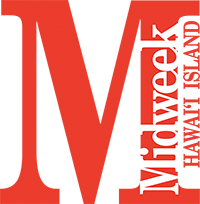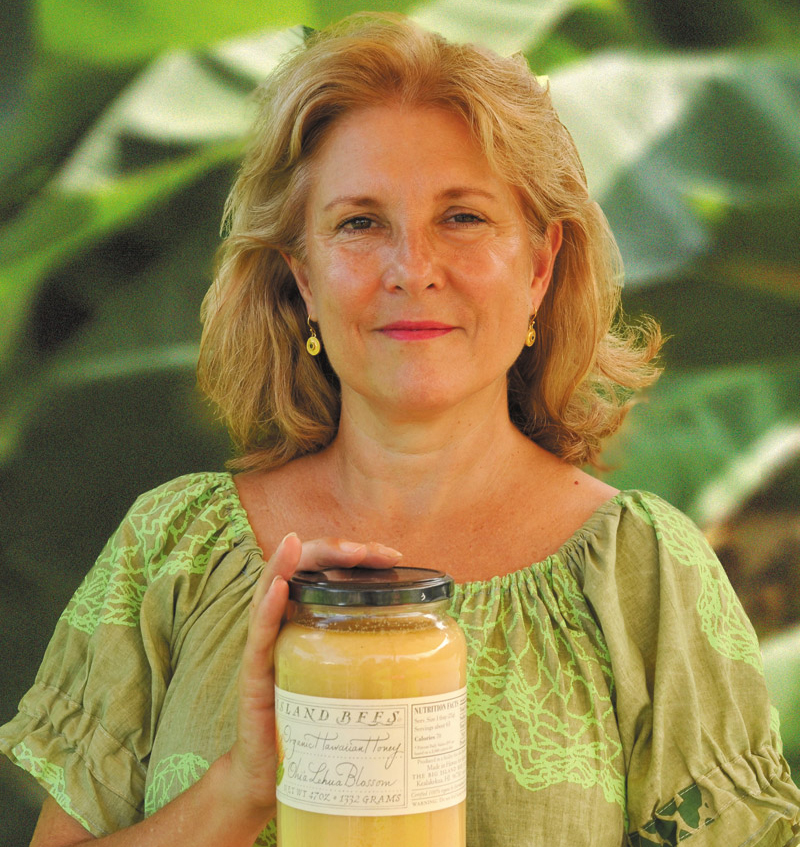Sweet As Honey
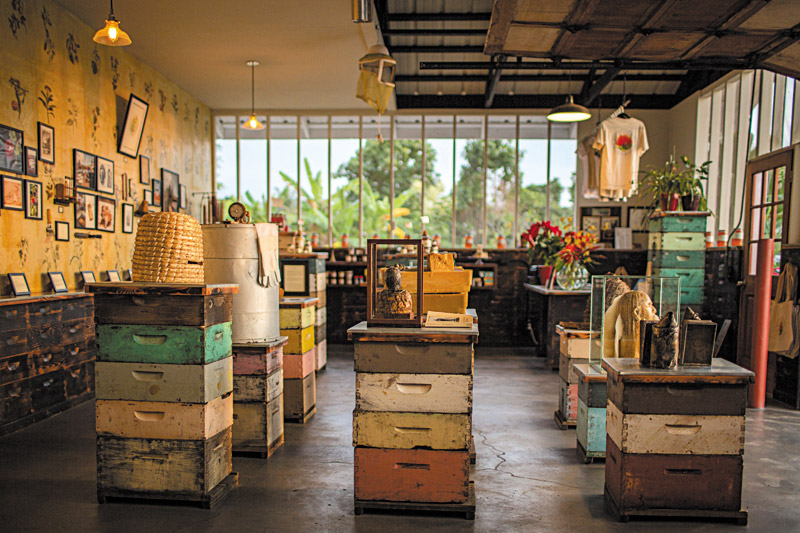
Find delicious ‘Ohi‘a Lehua Blossom honey on the shelves at Big Island Bees.
Things are abuzz at Big Island Bees, where delicious crops of honey are regularly produced as apiarists participate in a true labor of love.
For Garnett Puett and Whendi Grad, bee-keeping and commercial honey production are a multigenerational labor of love. Married since 1985, the couple are artists by training, and education and apiarists (beekeepers) by trade. Puett runs Captain Cook Honey Co., supplier to Big Island Bees, a beloved name in artisanal, locally grown honey. Grad is the manager, account executive, packer, distributor and marketer for Big Island Bees.
“Honey can be produced year-round on the Big Island,” says Grad. “Our 2,000 hives (containing more than 125 million bees) are transported in three continually rotating seasons each for ‘ōhi‘a lehua, macadamia nut and wilelaiki (Christmas berry) trees on the island. In fact, the macadamia nut orchards ask us to bring our hives to help pollinate their trees, and this same rotation has actually been in place with them continuously for the past 45 years.”
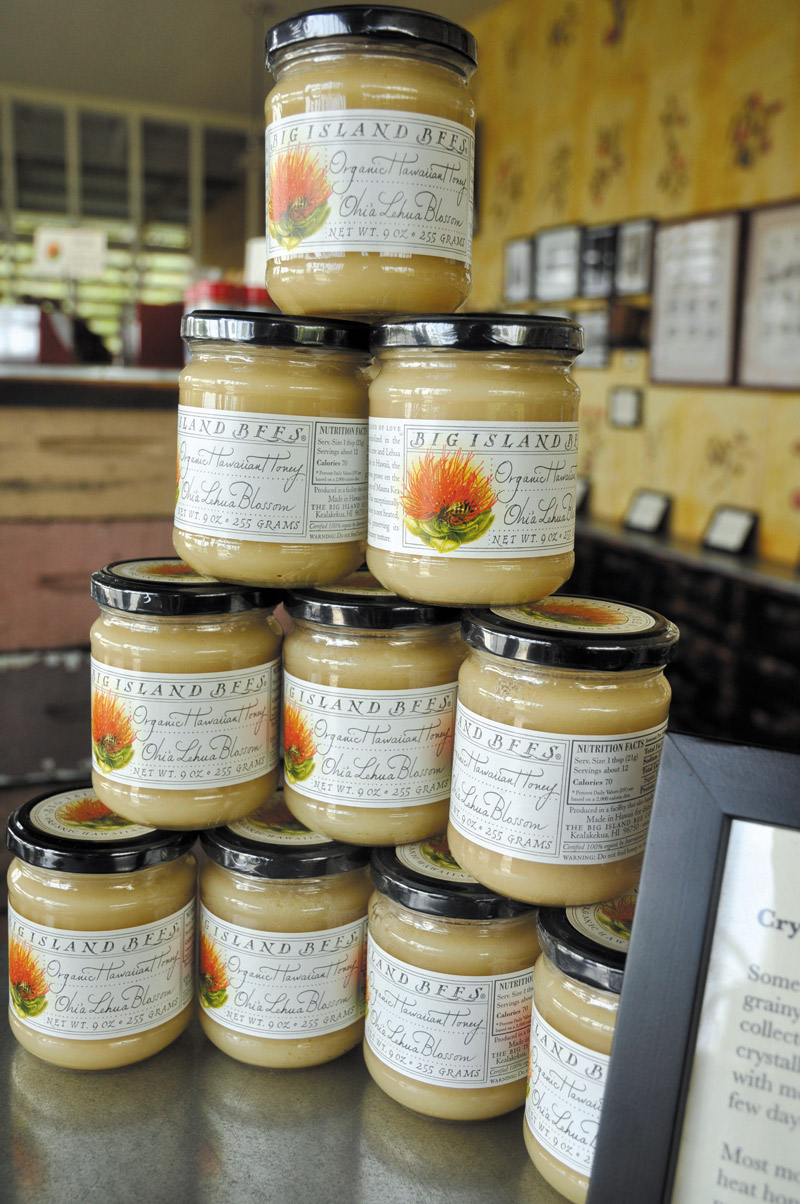
All of this is a hands-on operation. Puett says that to change rotations, they load the beehives on pallets at night onto a flatbed truck.
“The bees come in at night and we throw a shade cloth over them,” he says. “We are able to retrieve 99 percent of the bees. Then we move them to the next location. It is a lot of work, but it’s a labor of love.”
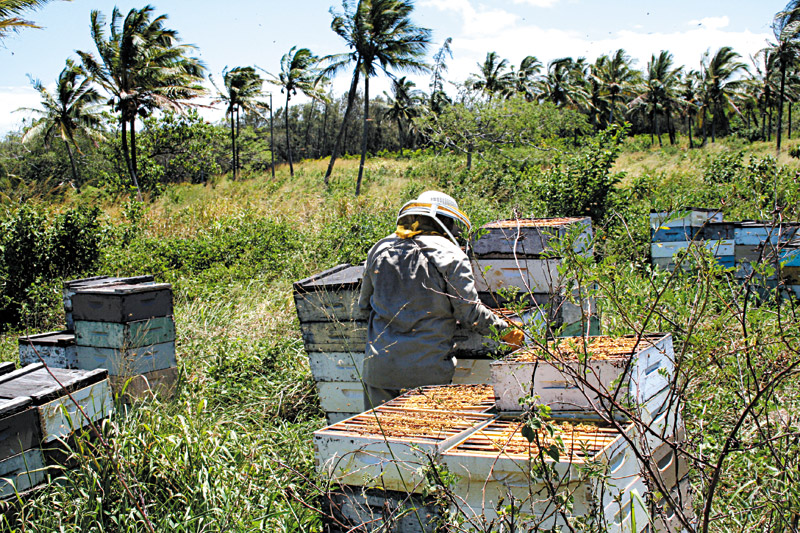
There’s a lot going on around the grounds of Big Island Bees. PHOTO COURTESY BIG ISLAND BEES
Each type of honey produced by Big Island Bees is prized for its unique flavor and texture. Grad says that the lehua honey offers a smooth, delicate taste along with its distinctive crystalized texture. Mac nut blossoms produce a chocolatey, nutty essence, while Christmas berry blossoms create a spicy and aromatic honey product.
Grad says the bees are never supplementally fed and get plenty of food from floral sources, resulting in a pure, raw honey that retains its nutritional value as well as remains true to the original floral source. They sell retail and wholesale to boutiques, grocery stores and big-box retailers, and produce bulk honey by the barrel for breweries, wineries, granola companies and bakeries. All the honey products are 100 percent certified organic (except the Macadamia Nut Blossom Honey because the orchards are not certified organic).
A Background in Art
Their story starts back in Hahira, Georgia, where Puett grew up. His great-grandfather raised queen bees, passing the business down to his son and grandson. In fact, the town soon became known as the “Queen Bee Capital of the World.” Then his father died suddenly when he was only 12, and Puett’s mom married another apiarist, Jim Powell, who founded Captain Cook Honey Co. on the Big Island in 1971, where Puett lived as a teenager. Puett met Grad in art school and both pursued careers as fine artists in New York City before moving back permanently, due to their love of the Big Island and the apiary business. Together with longtime partner Ben Cariaga (as well as his son), they’ve been running the operation themselves since 1988.
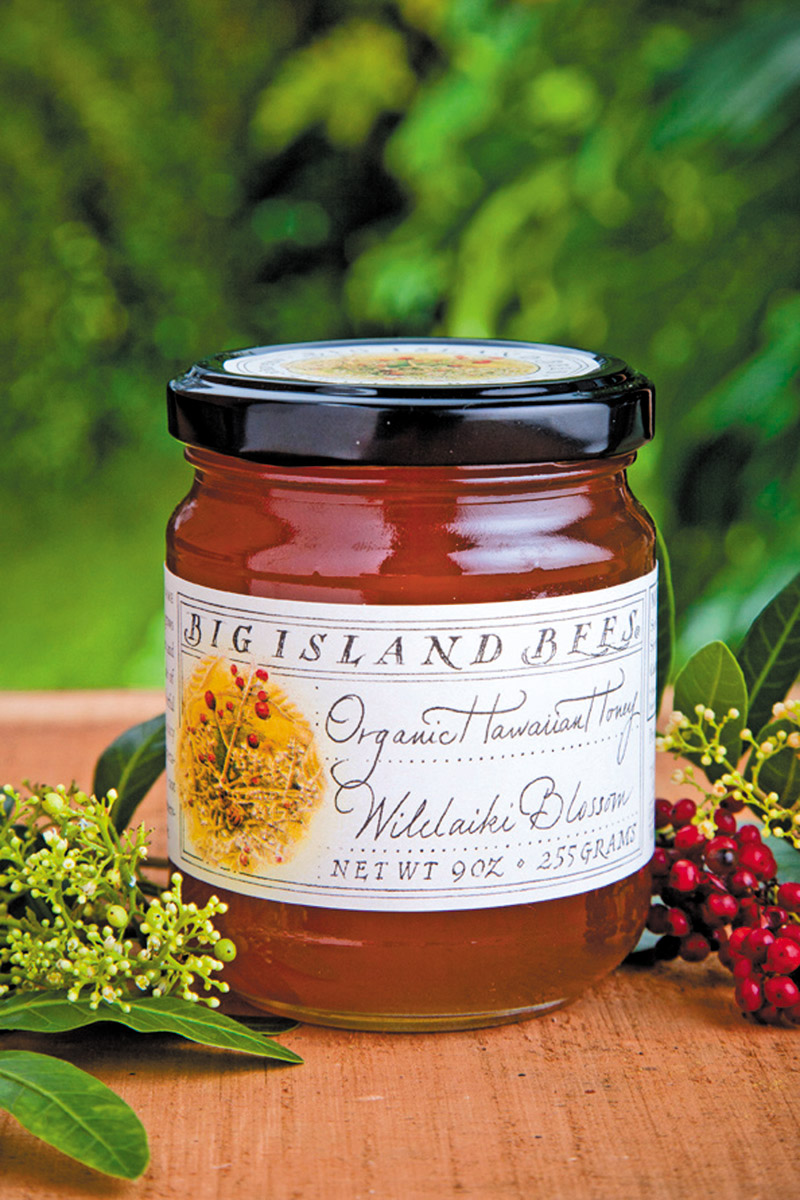
Another honey favorite is the Macadamia Nut Blossom.
“Garnett is extremely creative and really well known for his sculpture,” says Grad. “At the Pratt Institute in New York, he obtained a master’s in sculpture, and still has shows at a gallery in Brooklyn.”
Grad, for her part, also has a degree in fine art and worked in the furnishings textile industry, creating fabric swatches for such prestigious names as Hermann Miller before leaving big city life.
Parasites and Problems
Unfortunately, in recent years, apiarists on the Big Island have found themselves highly challenged by the introduction of pests and disease to local bee colonies.
“We now have only a couple thousand hives,” says Puett, “down from many thousands in the past, and that’s due to the pests we’ve been fighting here for about 10 years.”
Puett relates that the pests brought in include Verona mites and hive beetles that attack the weakest colonies.
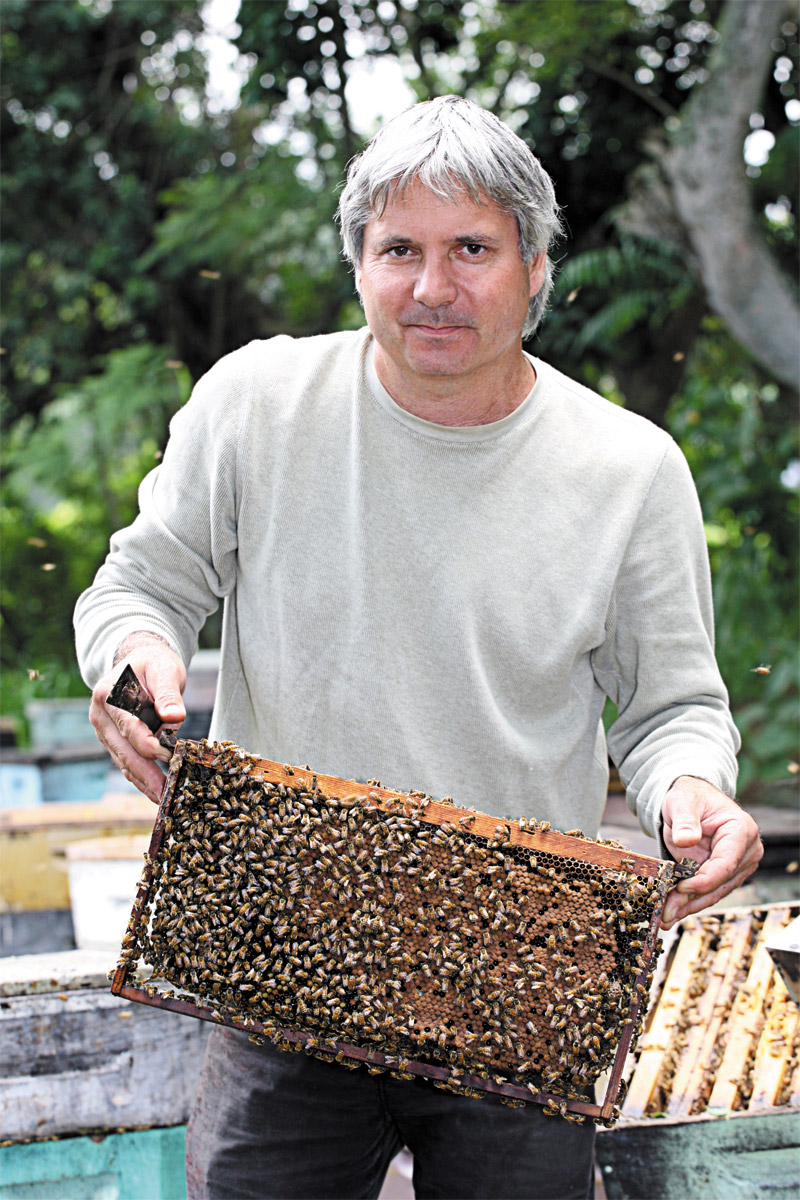
Garnett Puett holds a frame of bees. PHOTO COURTESY BIG ISLAND
BEES
“It’s very time consuming to treat and manage all the parasites, so this has caused a reduction in the number of hives we can maintain, and also a reduction in the output of honey.”
These pests also killed all the wild colonies on the Big Island.
“There have been no feral bee colonies here since 2011,” he says with sadness, noting that the eight commercial beekeepers on the island must all diligently manage the pests to keep the remaining bees alive. “Bees are also sensitive to environmental factors such as vog and ash, which affected portions of (the) island in arenas where the hives were located, so 2018 was not the best year for bees.”
This year, however, has produced an excellent crop of honey.
The Case for Christmas Berry
As anyone who has cleared a lot on the Westside knows, the ubiquitous Christmas berry (or wailelaiki, a relative of the Brazilian pepper tree) strikes a familiar sight, with its quick-growing, sometimes view-impacting branches and bright red berries. Most homeowners would love to see less of it. Turns out, it is not such a “junk” tree after all.
“The Christmas berry is wonderful tree; an incredible food source for bees and it blossoms at a time of year when nothing else does,” says Puett. “This medicinal plant has saved and helped a lot of bees, hives and honey here over the years.”
He says he is currently opposed to a possible state measure proposing biocontrols of Christmas berry in order to eradicate it.
“It would destroy Big Island beekeepers to get rid of it; we cannot let that happen.”
The work is challenging, difficult and labor intensive. Even U.S. Sen. Mazie Hirono, who visited and took a tour earlier this year, remarked that she couldn’t believe the amount of work involved in beekeeping and honey production. At its peak, Big Island Bees shipped out 700,000 pounds of honey, but has now reduced its output to about 400,000.
It has had to diversify, adding a museum, store and tours to the company offerings, which have built a following with locals and visitors alike. But it’s all very much worth it to Puett and Grad. Indeed, the public perception of bees as a valuable asset to the world also seems to be improving.
“People used to call me up really, really mad saying words I can’t repeat if the hives were bothering them,” relates Grad with a laugh. “But since we lost half the bee population within two years, people are more aware of their importance and are far more understanding and appreciative. That’s been the one bright side to all this difficulty.”
For more information, visit bigislandbees.com.
